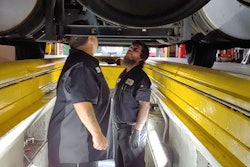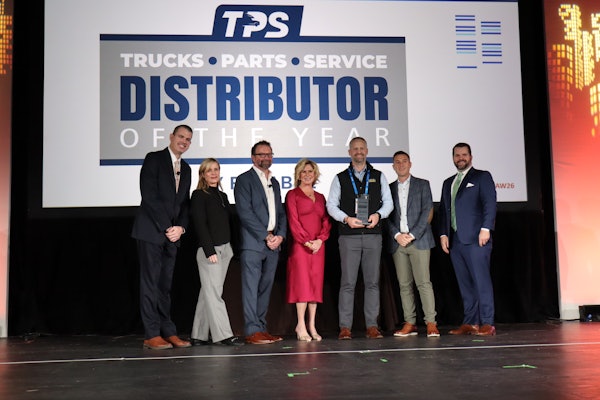
The Commercial Vehicle Safety Alliance’s (CVSA) International Roadcheck is quickly approaching. This year’s event is scheduled for May 4-6, 2021.
A primary vehicle focus for inspectors this year will be to pay special attention to lighting.
To assist service providers with helping their customers avoid lighting-related infractions, Trucks, Parts, Service (TPS) posed the following question to several industry lighting suppliers:
“What would you tell service providers to be on the lookout for regarding truck lighting in preparing their customers for the May Roadcheck to ensure they don’t get cited or pulled out of service?”
Alicia Jones, global market manager – trailer/body builder, Grote Industries
“It is often the unseen dangers of corrosion and wiring damage that contribute most to lighting failure on the road. Thorough, pre-trip inspections are important to detect compromised harnesses and wiring as soon as possible.
“Ensure all wiring is safely secured to prevent wear and that frayed wiring is immediately spliced out and properly sealed. Keeping your electrical system as watertight as possible is key to preventing corrosion that leads to lighting failure.”
Cory Adams, vice president of engineering, Peterson Manufacturing
“Make sure your lenses are clean. They may be functional, but if they are dirty, they may appear to be malfunctioning to an inspector. Ensure there are no signs of a cracked or damaged lens — this is a guaranteed entry point for moisture, which will eventually corrode the inside of your light and cause it to fail. Make sure your reflectors are actually reflecting light. Try to have a co-worker watch your vehicle as you drive around the parking lot — moving vehicles can have flickering lights and you’ll never see it when your truck and trailer is sitting still.
“Post-trip inspections are important [because] LED lights have circuit boards and if they get damaged they can overheat. Feel your lights at the end of your drive and see if there is any excessive heat, which is a warning sign you won’t [see] when you start your shift.”
Andrea Smeby, marketing content specialist, Phillips Industries
“Corrosion in the lighting electrical system is a key reason for lighting failures. Therefore, before the scheduled May 2021 International Roadcheck initiative, service providers should closely look for any open connection in the electrical system that would allow contaminates to enter, including the lighting system. Any contaminants entering the lighting electrical system can speed up the process of corrosion. Copper wiring acts as a sponge for water and contaminants. Corrosion that builds up at this connection will eventually cause lighting failures.
“In addition to looking for open connections where corrosion can breed, when making repairs or servicing your customers’ lighting systems, our recommendations are to use lights with sealed housings and di-electric grease on all connections and always use heat shrink terminals. It is also a good idea for you to replace the pigtail connection when lamps are replaced. Old lighting pigtail connections can lead to corrosion on the pins of the new lamp.”
Kyle O'Dell, director of engineering and new product development, Optronics International and USA Harness International
“As a service provider, no doubt you have already been adhering to a well-documented PM protocol, including the periodic examination of a vehicle’s entire electrical and lighting system. With this year’s mechanical fitness emphasis on lighting, you’ve put your customer in a great position to get through International Roadcheck 2021 without an infraction.
“The best thing to do now is help your customer help themselves as the event draws near. In the 2020 U.S. event, 88.4 percent of OOS violations could have been avoided by just making sure that a vehicle had all of its lights working for the three days [of the event], and 45.4 percent of the OOS violations could have been avoided by checking to make sure the turn signals were working.
“Since drivers are required by law to inspect their truck and trailer before starting their shift and again every 24 hours on the road, they need to be encouraged to do just that during the event — and frankly, ever after.”
Andrew Liuzzo, marketing communications specialist, Truck-Lite
“Vehicle safety starts with a thorough inspection before the start of a trip, focusing particularly on marker lighting, as non-functioning lamps may appear lit on a sunny day. In addition to being functional and intact, lights and reflectors, including reflective tape, must also be clear of any dirt and debris.
“An all-LED lighting system offers an exponentially longer lifespan and a fraction of the current draw compared with incandescent lighting. Also, an LED system is far less likely to fail or otherwise compromise a vehicle’s electrical system. With LED lighting, a light should be replaced even if a single diode failed. However, an LED lamp that appears to be dim or unlit often indicates a larger issue relating to the electrical harness or connectors.
“A periodic review of a wiring system is crucial to performance and preventive maintenance: the longer you can maintain the integrity of a vehicle’s wiring harness, the better your lighting system will perform.”
Lighting violation data
In related news, the lighting violation “lamps inoperable” (Title 49 Code of Federal Regulations 393.9) was the top vehicle violation in fiscal year 2020, accounting for approximately 12.24 percent of all vehicle violations discovered that year, according to the Federal Motor Carrier Safety Administration (FMCSA).
Following are the toughest 15 states for lights violations based on federal data mined by RigDig and TPS sister publication Overdrive. The list indicates the states that put the biggest priority on lighting in inspections, relative to what else they tend to find wrong. The percentages are of all violations issued by state for lights-related infractions.
- Florida – 24.2 percent
- Texas – 23.5 percent
- Mississippi – 23 percent
- Alabama – 22.7 percent
- Ohio – 22 percent
- West Virginia – 19.9 percent
- Maryland – 19.4 percent
- Vermont – 19.3 percent
- Virginia – 19.3 percent
- Nevada – 19.2 percent
- Connecticut – 18.9 percent
- Kansas – 18.9 percent
- North Carolina – 18.9 percent
- Wisconsin – 18.6 percent
- Georgia – 18.2 percent









